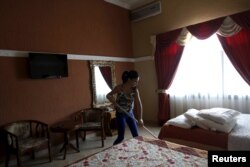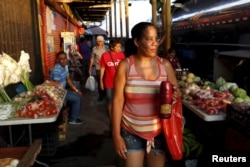A new bottleneck of Cuban migrants bound for the United States has formed this month in Panama, threatening a fresh diplomatic headache in Central America after thousands were flown out of the region earlier this year.
Just as Barack Obama was making the first visit to Cuba in 88 years by a U.S. president, 1,500 migrants from the communist island were bunched on Panama's border with Costa Rica, struggling to reach the United States to start new lives.
The buildup followed the airlift of about 6,000 Cubans from Costa Rica and Panama, which ended last week.
However, another knot of migrants has grouped in western Panama since Costa Rica stopped issuing Cubans transit visas in December to try to stem the human tide that clogged up its border with Nicaragua last year.
"If I hadn't left Cuba, I would have ended up in prison because I love freedom and having options," said Halena Leiva, 31, who has worked as a cleaning lady in the Panamanian border town of Paso Canoas since she ran out of money on her way north.
During his 48-hour visit this week, Obama challenged Cuba's government with calls for democracy and new economic reforms.
Cuba has loosened restrictions on private enterprise in recent years, creating a growing middle class, but most people still earn tiny wages and many of the young wish to work abroad.
'Good change'
"With the visit of Obama, this is the beginning of a good change," said Cuban welder Isbel Loriete, 45, who was confident he would find plenty of work in the United States once he got out of Panama. "Every change is good."
Last year Cubans took advantage of an open-door policy in Ecuador to head northward, fearful that decades of preferential U.S. policy toward them could be ending.
Running the gauntlet of corrupt police and people smugglers, Cuban migrants young and old made the long trek before Cuba stepped up pressure on its allies in the region, such as Nicaragua and Ecuador, to halt the surge.
Nicaragua sealed its border in late November and Ecuador imposed visa requirements on the Cubans beginning in December. By then, many of the migrants were already in South America.
Over 7,000 were trapped on the Nicaraguan border, and only after much diplomatic wrangling did Central American nations in late December agree to airlift most of the stranded Cubans out. Costa Rica said a final group of migrants left just last week.
Still, seven to 10 migrants are still turning up at the Panamanian border every day, on average, local officials say.
Luis Hincapie, Panama's deputy foreign minister, said Wednesday that Central American countries, as well as others including Ecuador, Colombia, the United States and maybe Cuba, aimed to schedule a summit to discuss the issue in Guatemala.










